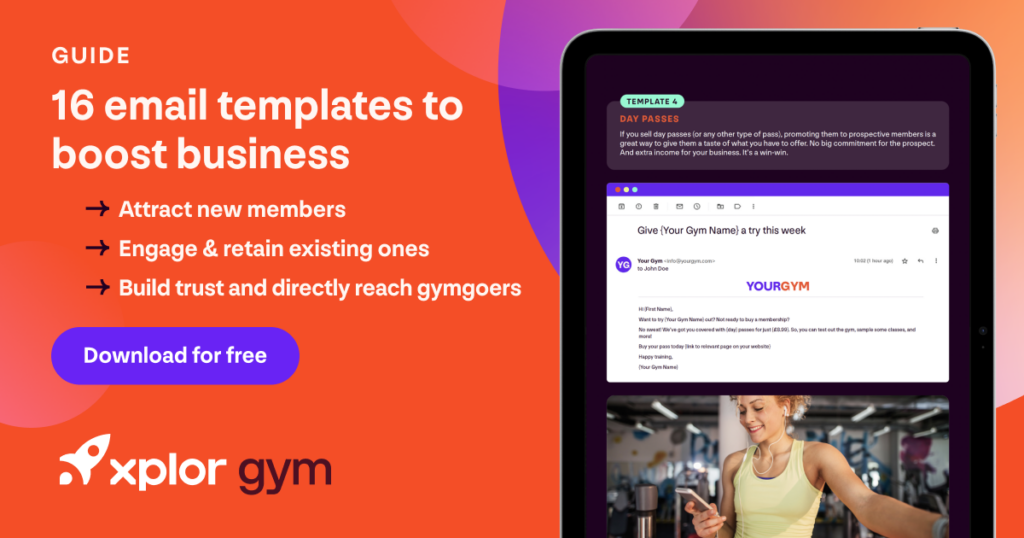To stand out, you need solid gym marketing strategies that support your business goals. Then build a marketing plan for your gym filled with the right tactics to help you achieve your goals.
There are 4,880 gyms, health clubs and fitness centres in the UK. This has grown by 9.6% a year on average from 2018-2023. This growth represents opportunity for your fitness business. Yet, it also shows how competitive the market is.
You need the right approach to creating your marketing strategy if you want to stand out and reach the right audience. Many gym owners and operators are incredibly busy. And that means there’s not much time to create an effective gym marketing strategy and plan.
We’re here to help. In this guide, we’ll run through the essential need to knows to help you build a marketing strategy and plan.
Let’s get stuck in!
Power up your business & stay in the know
What is a marketing strategy?
“There will always, one can assume, be a need for some selling. But the aim of marketing is to make selling superfluous. The aim of marketing is to know and understand the customer so well that the product or service fits him and sells itself.”
Peter Drucker, Management: Tasks, Responsibilities, Practices (1973)
While this quote from influential management thinker, Drucker, is 50+ years old, it remains true in many ways. If you can get marketing right, you’ll reach your target members and get them to know, like, and trust you. So, they’re ready to sign up and stick with you for the long-term.
What is a marketing strategy for a gym? It’s your game plan. It’s how you’ll reach prospective members and convert them into members. Gym marketing strategies will centre around a company value proposition. Your value proposition should explain what you stand for, how you operate, and why members should choose you.
Your marketing strategy should help your fitness club achieve sustainable success. It will align your marketing goals to business goals. And identify what you need to achieve those marketing goals.
Gym marketing strategies vs plans
The two terms are often used interchangeably. Yet, there is a distinct difference between a marketing strategy and a marketing plan. What’s the difference?
- Marketing strategy – this is the reason for investing in marketing. It’s aligned to what your business wants to achieve. It will include details of your goals, campaign objectives, target audience, marketing channels, and competitive landscape.
- Marketing plan – this is how you’ll achieve your marketing strategy. It outlines the steps you’ll take to achieve your marketing goals – the tactics you’ll use.

Creating a gym marketing strategy
How do you create a marketing strategy for your gym or fitness club? It can seem daunting but it’s not that complicated! Follow these steps and you’ll have a comprehensive, successful marketing strategy:
1. 4 Ps of marketing
The ideal starting point. By documenting your marketing mix – known as the 4 Ps of marketing – you’ll be set up for success.
Product
What are you selling? This will be the products, services, and equipment that your gym or fitness club offers. It will include membership packages, as well as other access options. Plus, if you’re selling physical products, like clothing or food, it includes these too.
Price
The cost of the products, services, and equipment that you are offering. Think about value as well as the price of what you are delivering.
Place
This will usually be your physical location. If you sell products online and/or offer a digital membership, include the location of these too. For example, protein shakes are available from our London Bridge gym and on our website.
Promotion
Identify where you’ll promote your products, services, and equipment. Your promotional tactics. For example, Facebook, Instagram, Google Ads, your website, ads in a local newspaper, etc.
2. Marketing goals
These are essential to your strategy. They will determine other elements of your strategy and then plan.
Much like you help new members set SMART goals during onboarding, you should make sure the goals in your gym marketing strategy are SMART. That means each goal should be:
- Specific – what do you want to achieve? Why is it important? Who will be involved? Where is it located? What resources or limitations exist?
- Measurable – being able to measure and track progress will help you (and your team) stay motivated towards a goal. It will also help you know when you’ve achieved each goal
- Achievable – while you want to be ambitious in setting your goals, you also want them to be attainable and realistic
- Relevant – your marketing goals must align to bigger business goals in some way. Or be relevant in another way that moves your business forward
- Time-bound – your goals should have a deadline you can work towards to help you prioritise them
Here are some examples of gym and fitness club marketing goals that have been built using the SMART framework:
- Increase brand awareness by growing Instagram followers by 10% within the next 6 months
- Increase retention rates by 10% within the next 9 months
- Increase total membership revenue to £150,000 a month within the next 6 months
- Achieve at least 90% occupancy of Tuesday night BodyPump classes in the next 3 months
3. Budgets
This is an essential part of your marketing strategy. You’ll need to invest in advertising, content, talent, and anything else you need to achieve success. Setting a budget will help you achieve return on investment. Budgets help you stay in control of spend and optimise towards areas that are having most impact.
When you’re starting out you likely won’t have performance data. A starting point can be to focus on your target audience and where they are most likely to learn about your business.
Focus on a few key areas. Measure performance. And then allocate more budget to areas that are working or expand out to new areas.
When setting an initial marketing budget, divide costs into ‘buckets’ for example:
- Email & SMS marketing
- Social media advertising
- Search engine marketing
- Retention
- Referrals
- Website
4. Competitive landscape analysis
You need to understand the landscape around your business. That means understanding the gyms and fitness clubs around your location(s). And considering your digital competition.
Once you understand who your competitors are, how they market themselves, their size, any specialisms, their reputation and more, you can consider where your fitness business currently fits in.
There may be gaps in the market you could fill. Or the opportunity to create local partnerships to benefit your members.
5. Segmentation, targeting and positioning
You need to know who your target membership base is. And then create the right messaging to attract those members.
Think about who your ideal member would be. Already have an existing member base? Yes, then you can look at your data when creating this, as well as looking at the market in your area. Think about the following (you may have many personas within your target membership base):
- Demographics – who is your member/who are your members? For example, age, gender, location, profession, income, etc.
- Lifestyle – for example, hobbies, non-work activities, entertainment tastes, etc.
- Behaviour – for example, loyalty to specific brands, social media used, communication preferences, etc.
- Psychographics – why do your ideal members buy what they buy. For example, beliefs and values, personality traits, personal priorities etc.
You can use this data to create target buyer personas that you can focus your activity towards.
You’ll need to think about your positioning. This should explain why a prospective member should choose your gym. How do you stand out from the competition? What key messages do you need to get across?
6. Marketing channels
You should know who you are targeting and the messages you need to get across. So, you can choose the best channels to use.
Where will you find your target audience? For example, if you are trying to attract members born from 1997 onwards (Gen Z), you may want to focus on TikTok & Instagram. Even Google has admitted that almost 40% of young people will search TikTok or Instagram rather than Google Maps or Search.
7. Measure success
Want to understand how well your marketing strategy is working? You’ll need to track and measure performance of your marketing metrics. When creating your strategy decide which metrics to focus on.
The metrics and key performance indicators (KPIs) you choose will depend on your goals, marketing mix and channels. Common marketing KPIs include:
- Web traffic – how many unique visitors are you attracting to your website
- Conversion rate – what percentage of those visitors are converting to an enquiry or membership sale
- Click through rate – what percentage of your audience click through from an email, text message or social channel

What makes a successful gym marketing strategy?
The success of your marketing strategy will be determined by many factors. Ongoing awareness of your target membership base, the fitness industry in general and the world around you is essential.
These are some of the factors that will help you achieve success.
Get personal
Personalisation has never mattered more to consumers – 71% expect it. And, when used well, personalisation can increase profitability. Companies generate 40% more revenue from activities using personalisation compared to those who aren’t using it.
Email and SMS marketing offer your fitness business an easy way to personalise marketing to prospects and members. Segment your membership base by demographics, preferences, and more. Create triggers to send out messages at the opportune time in a member’s journey with you.
Use data within your software to personalise emails to each member. That could mean adding a name to a subject line or telling them how many visits they’ve achieved this month. Use the gym marketing software capabilities in your management system to send personalised emails. And target them to specific audience segments to resonate with each member.
If you can delight members by making them feel seen and heard, your strategy is more likely to be successful.
Go omnichannel
Omnichannel marketing uses a consistent approach to messaging and visuals across a mix of online and offline touchpoints. And omnichannel marketing goes beyond multichannel marketing to create an integrated, seamless experience for a member.
When you’re starting out, it’s important not to spread yourself too thin when it comes to marketing. Focus on a few channels that you know are most relevant for your target members. Make sure that you are consistent throughout for a joined-up member experience.
That might mean running campaigns across 2 or 3 channels. And making sure that the experience prospective members get matches up to your member experience.
Always deliver on promises you make in your marketing. Your members are savvy and will recognise when expectations fail to live up to reality.
Be relatable & authentic
By getting personal and going omnichannel, you’ll be taking strides towards making your marketing relatable and authentic.
Research has shown that 88% of consumers say authenticity is important when deciding which brands to support. Being authentic in your marketing means staying true to your positioning and promise.
This article on entrepreneur.com gives some fantastic advice on creating authenticity:
- Develop a consistent brand voice and personality that resonates with your target audience. It should also extend to in-person interactions throughout the member journey
- Choose where and what you engage in. Avoid following trends that don’t fit with your brand and values – this can be especially true on social media
- Personalise interactions. Use all data available to personalise each communication with members. Show the most relevant content in your marketing communications for each individual
- Have a single member view. If you’re working across a variety of different systems, there’s greater risk of duplicated and inaccurate data. This can negatively impact a member’s experience. Especially if your team doesn’t have the complete member view they need to answer questions. Choose an all-in-one fitness club management software that includes payments and marketing. So, you’ll have a complete 360°-member view with data that’s up-to-date and accurate at all times.
Keep in mind that it’s not just words that need to resonate with members. Pick the right imagery too. Think about what fits with your brand. And choose diverse imagery that reflects your audience.

Putting your gym marketing strategy into action
Once you have a marketing strategy for your gym, you can go about creating a gym marketing plan. This is a strategic roadmap that you can use to organise, execute, and track the progress of your marketing strategy. It will help you align your marketing activities to specific business goals.
Marketing channels
When creating a marketing plan, look back to the channels you identified within your strategy. In your plan you’ll detail exactly how you’ll use those channels. Let’s look at the most effective channels for gyms and fitness clubs.
Gym email marketing is a highly effective option for gyms and fitness clubs. It gives you direct access to an audience who’ve chosen to hear from you. And uses a channel you own. Email marketing puts you in control.
84% of consumers check their emails at least once a day. This gives you an opportunity to get in front of your prospects and members.
What are the best tips for email marketing success in 2024?
- Take a targeted approach
- Get personal
- Send at the right time
- Write an attention-grabbing subject line

SMS / text message
SMS marketing can be incredibly powerful. Why? SMS open rates can be as high as 98%. Careful use of text messages will help you get in front of your audiences.
Here are some top tips for successfully using SMS marketing:
- Keep it relevant
- Get to the point fast
- Be mindful of when you send
Social media
Away from email and SMS channels that your business has control over, gym social media marketing is a must for most fitness clubs.
With your target audience in mind, consider which channels you should focus on. Facebook and Instagram tend to be the most popular. And TikTok is growing in popularity amongst younger gymgoers.
Whichever channels you choose, content is key. Make sure you are posting regularly and have a plan that’s built around your overall marketing strategy. You also need to dedicate time to engage with your community. Look to create a community rather than building a following.
This is one of the most established social media platforms around and is owned by Meta. It’s most popular with older professionals aged 25+. To use Facebook, create a business page for your fitness club. That will give you access to Meta for business where you can run ad campaigns and access insights into the performance of your campaign posts.
Keep your profile up to date with key information like your contact number, address, open hours, and website.
Another huge social media platform, also owned by Meta, Instagram has around 35 million users in the UK as of February 2023. It is most popular with Millennials (born 1981 to 1996) and Gen Z (born 1997 to 2012). Set up an account for your business and you’ll get access to all the business tools the platform offers.
Instagram is all about images so make sure you use good quality photos from your club. Ask your members to tag you when they post from your gym. These tags will increase your reach and are great user generated content you can share on your profile.
To increase your visibility, use hashtags:
- Create one for your gym
- Find popular ones for your local area (e.g., if your club is in Manchester use #manchester)
- Use popular daily ones like #MondayMotivation, #TransformationTuesday, #WorkoutWednesday, #FitnessFriday, #SweatySunday, etc.
Always keep your posts relevant to the hashtags you choose to use.
TikTok
TikTok exploded in popularity during the COVID-19 pandemic. It has over 3.7 million active users in the UK – 26% of those are aged 18-24. If you are targeting younger gymgoers, TikTok can help prospective members find you. As with Facebook and Instagram, you can create a TikTok for Business account to get access to the tools it offers marketers.
TikTok is all about shortform video. So, if you choose this social channel, you’ll need to get creative! Posts typically revolve around challenges, reactions, humour, and knowledge sharing. Think about what fits best with your brand. TikTok is about having fun so keep it light.
Use your TikTok videos on Facebook & Instagram as reels to drive engagement.
Paid social advertising
Paid advertising on social media can help you grow your business. Facebook, Instagram, and TikTok all offer the ability to increase your reach with paid advertising options. As with all marketing, think about your audience and your goals to find the right approach to paid advertising on social media.
Most paid social advertising works on a pay-per-click (PPC) basis. Set a budget for your campaigns and a clear goal. You may want to promote a special offer for new members or increase your social media following. Take time to create an appealing ad that’s clear and resonates with your target audience.
Make sure you have the right tracking in place on your website to measure success. Remember to make sure your website is compliant with Privacy and Electronic Communication Regulations in how you use tracking cookies and technologies.
Website & user experience
Your prospective and existing members are more tech savvy than ever before. And expect your user experience to live up to their expectations. Think about your whole online member journey. Whether a prospective member clicks through from Facebook or from a digital advert, the online journey should be seamless.
Use your gym membership software to create a seamless member experience. An experience that starts with online joining technology that’s integrated into your website. Then extends to payments, communications and more. Remember that selling a membership is just the beginning of a member’s journey with you.
Find out what makes a successful new gym member journey.
Search engine optimisation (SEO)
It’s second nature now to head to Google when you want to find something out. For those new to an area (and even those who’ve been in the area for some time), it can be the first port of call when looking to join a gym or fitness club. If you want to show up, you need to work on your search engine optimisation (SEO).
SEO for gyms is the process of making sure you show up in a high position on a search engine results page (SERP) when someone searches for relevant terms. SEO can get quite complex. Yet, it’s surprisingly simple for most gyms and fitness clubs to get started.
Focus on local SEO first. This subsection of SEO focuses on components of search to help you increase traffic and visibility in a specific geographic area.
Make sure your club has a Google Business Profile set up (this is free). And that it’s as complete as possible. Keep it up to date. Add regular posts, photos, request & respond to reviews, and answer questions people have asked about your business. List your business on directories like Yell, Bing, Yelp, and 192.com.
Try to work out what prospective members may be searching for. Google Keyword Planner is a good starting point. Use it to find out more about words or phrases relevant to your business that are being searched for in your local area.
Add those keywords to your website. Start by adding one or two to your homepage (or another important page like one with an overview of your memberships). Always use keywords and phrases naturally in your copy.
Master SEO
TipThis complete guide gives you all you need to master SEO. So, you can elevate your online presence and win new members.
Get stuck in!Search engine marketing (SEM)
Whereas SEO helps you show up organically on Google and other search engines for relevant search terms, search engine marketing (SEM) is the practice of using paid ads to show up. Just like SEO, SEM is an important part of a digital marketing strategy for your gym.
By bidding on specific keywords, you’ll show up alongside organic results. Often known as pay-per-click (PPC) ads, due to a charge paid for each click, these ads come in a variety of formats. Typically, if you want to show up on the Search Engine Results Page (SERP), the format will be a text listing.
SEM is an effective way to get your ads in front of prospective members who are looking to sign up for a gym or fitness club membership.
Influencer & co-marketing partnerships
You’re probably familiar with influencer marketing. An influencer is someone who has a loyal following on social media. Partnering with local fitness influencers can help you grow your business. You can also look at reciprocal co-marketing partnerships with local businesses who have a similar target audience to your fitness business.
Identify fitness influencers and co-marketing partners who would be a good fit for your gym and have a following amongst your target audience. Think about how you can work together for the benefit of both of you. For example, sponsoring content, hosting an event in your club, or collaborating on an offer.
Build a relationship and develop an agreement before entering a partnership. Set clear metrics that you’ll track to measure success. Always make sure that any sponsored posts are appropriately promoted as such.
Word-of-mouth marketing
Let your members act as a marketing channel for your business. Word-of-mouth marketing can be incredibly powerful. Refer-a-friend promotions, reviews, and sharing social content from members are word-of-mouth marketing.
Research has found that 88% of people trust recommendations from people they know more than any other type of advertising. Plus, 77% are more likely to go onto make a purchase after receiving advice from someone they trust.
Word-of-mouth marketing can even attract higher value members to your fitness business. Research has shown that a consumer who has received a recommendation will spend 2x more and go on to make 2x as many referrals themselves.
Campaign inspiration
Those are some of the marketing channels used by gyms and fitness clubs. Next up when putting your gym marketing strategy into action, you need to build marketing campaigns aligned to your goals. These should be omnichannel. Running across 2 or more channels for impact. And creating a seamless member experience.

Measuring marketing success
It’s important to track and measure the performance of your marketing activities. By setting SMART marketing goals for your strategy, you should have targets to help you understand what you should be looking to achieve.
These are just some of the ways you can measure the success of your fitness marketing plan:
- Website performance – use a tool like Google Analytics to understand how your website is performing. If you are driving traffic to your website, you’d expect sessions to increase, more time to be spent on your site and the number of conversions to increase
- Email and SMS open and click through rates – within your gym management software you should be able to track open and click through rates
- Memberships – look at how many new members you are signing up, your retention rate and average length of stay to track performance
- Return on investment (ROI) – ultimately, you are looking to make more from your marketing activities than you spend on them. Looking at ROI on a channel and campaign basis can help you identify what has worked most efficiently for your business
- Social media reach and engagement – if you are looking to grow your social presence looking at stats, like the number of followers you have, the reach or impressions your posts get, and engagement rates, can help you measure performance
The wrap up…
The fitness industry is competitive. And that means your gym or fitness club needs to work harder than ever to stand out. Choosing the right gym marketing strategies will help you attract the right type of member to your business. And keep you focused on your overall business goals.
Creating a marketing strategy is easy when you know how. A successful strategy will make use of personalisation. It will be omnichannel. And position your business as relatable and authentic. Once you’ve laid out your strategy, you can turn it into a tactical marketing plan.
There are many marketing channels available. Choose the ones that will help you achieve maximum reach with your target members. Use a multi-channel approach to really supercharge marketing performance.
There are a lot of gym marketing ideas that can inspire your campaigns. Focus on the mix of activities that will get you furthest towards achieving your marketing and business goals.
Get the fuel to go further. Request a demo to see the value that Xplor Gym can bring to your fitness business.

by Joanna Ashton Content Marketing Manager, Xplor Gym
-
First published: 26 February 2024
Written by: Joanna Ashton
